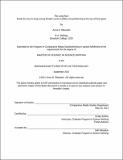| dc.contributor.advisor | Anthes, Emily | |
| dc.contributor.author | Blaustein, Anna | |
| dc.date.accessioned | 2022-02-07T15:26:21Z | |
| dc.date.available | 2022-02-07T15:26:21Z | |
| dc.date.issued | 2021-09 | |
| dc.date.submitted | 2021-07-06T15:14:50.768Z | |
| dc.identifier.uri | https://hdl.handle.net/1721.1/140139 | |
| dc.description.abstract | Athletic participation is overwhelmingly positive for girls and women, but it is not without risk. Many female runners — and other female athletes — don’t eat enough given how much they exercise. The motivations driving this underfueling are complex and range from short-term improvements in performance to societal pressures on women to be thin. In the long run, underfueling causes a host of health complications that may end seasons or athletic careers. Many girls and women will do lasting damage to their bodies.
The issue has gotten increasing attention over the last few years as professional and collegiate runners have shared their experiences with the condition, known as Relative Energy Deficiency in Sport (RED-S). The conversation has largely overlooked the middle- and high-school aged girls who are also affected, however. Doctors and researchers are now in a race of their own to understand RED-S and keep young female runners healthy and performing at the top of their game. | |
| dc.publisher | Massachusetts Institute of Technology | |
| dc.rights | In Copyright - Educational Use Permitted | |
| dc.rights | Copyright retained by author(s) | |
| dc.rights.uri | https://rightsstatements.org/page/InC-EDU/1.0/ | |
| dc.title | The Long Run: Inside the race to keep young female runners healthy and performing at the top of their game | |
| dc.type | Thesis | |
| dc.description.degree | S.M. | |
| dc.contributor.department | Massachusetts Institute of Technology. Graduate Program in Science Writing | |
| mit.thesis.degree | Master | |
| thesis.degree.name | Master of Science in Science Writing | |
